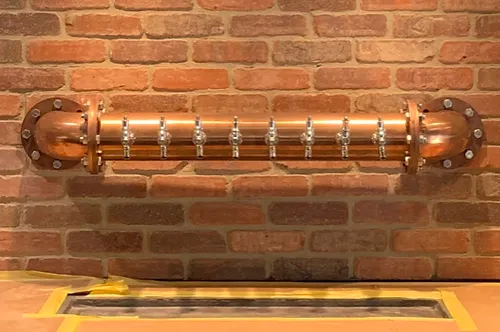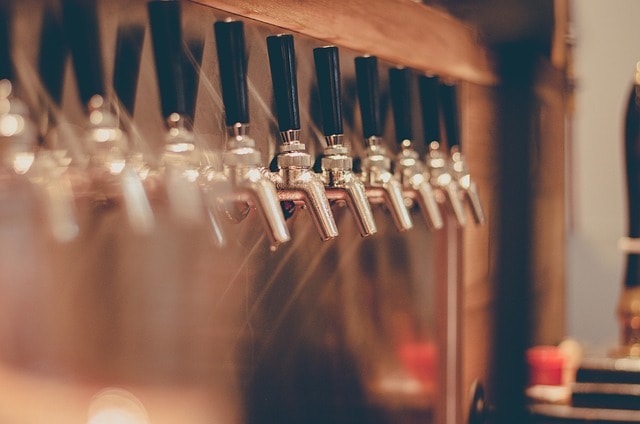CO2 Usage in Draft Beer: Ensuring Optimal Freshness and Carbonation

Carbon dioxide (CO2) plays a vital role in the dispensing of draft beer, beyond just giving your favorite brew its signature fizziness. The use of CO2 for beer, in draft beer systems is a precise science that ensures the beer maintains its quality from keg to glass. CO2 pressurizes the keg, pushing the beer through the lines and out of the tap, but it’s also important for maintaining the right level of carbonation, which affects the beer’s taste, aroma, and mouthfeel.
Understanding the intricacies of CO2 usage is essential for anyone involved in the dispensation of draft beer, whether it’s in a commercial setting or a home bar. From setting up the equipment correctly to troubleshooting common issues, the knowledge of how CO2 interacts with beer can make the difference between a flat pint and a perfectly poured one. This includes knowing how different pressures might affect various beer styles or how to adjust your system to avoid over-carbonation or under-carbonation, both of which can detrimentally impact the beer’s overall character. Knowing the beer temp is crucial as it directly affects CO2 volumes and carbonation levels, ensuring the proper PSI is set for the desired carbonation.
- CO2 is essential for both propelling and carbonating beer in draft systems.
- A proper understanding of CO2 use is critical for serving quality draft beer.
- Management of CO2 pressures can vary with different beer styles.
Basics of CO2 in Draft Beer Systems
In draft beer systems, CO2 is vital for carbonation and dispensing. This section discusses the gas’s fundamental role and the types commonly employed in keg systems.
The Role of CO2 in Carbonation
Carbon dioxide (CO2) is responsible for carbonating beer within a keg, infusing it with the signature fizziness that consumers expect from draft beer. CO2 dissolves into the beer under pressure, creating carbonation. The CO2 tank is connected to a primary CO2 regulator, which assures the gas is delivered at the correct pressure to maintain optimal carbonation levels from the keg to the tap. Additionally, corn sugar (glucose monohydrate) is often used as a priming agent in homebrewed beer to achieve the desired carbonation levels by dissolving it and combining it with fermented beer.
Types of Gases Used in Draft Beer
While CO2 is the primary gas used in draft beer systems for ales and lagers, a blend of nitrogen and CO2, known as beer gas, is also utilized, especially for certain stouts and nitrogenated beers. These gases are provided by specialized tanks and are crucial for maintaining the desired taste and texture of the beer as it is dispensed. The proportion of gases in these blends, such as a 70/30 mix of CO2 to nitrogen, varies based on the type of beer being served.
Draft Beer Equipment and Setup
Proper setup of draft beer equipment is crucial for ensuring the quality and consistency of pour. This includes understanding the necessary components, how CO2 tanks and regulators function, and the fine-tuning required for balancing the system.
Essential Components of a Draft Beer System
A typical encompasses several key parts. Firstly, there's the keg coupler, which attaches to the keg, allowing beer to flow. The CO2 tank supplies pressure, pushing the beer through the beer line. At the end of the line, a faucet releases the beer into your glass. Each component must work in harmony to dispense beer at its best.

CO2 Tanks and Regulators
The CO2 tank and regulator are central to a draft system. The tank stores CO2 gas, while the regulator controls the gas flow and pressure, indicated by a CO2 gauge. It's crucial that these are high-quality and properly maintained to ensure consistent pressure for optimal beer dispensing.

Balancing the Draft Beer System
Balancing involves adjusting the system so the beer pours correctly. Variables such as applied pressure from the CO2 tank, the length and inner diameter of the beer line, and the type of keg coupler used must all be considered. A balanced system results in a perfect pour with the right amount of foam. Additionally, understanding how to properly bottle conditioned homebrewed beer can significantly affect the balance and carbonation levels, ensuring the desired carbonation is achieved.

Troubleshooting Common CO2 Issues in Draft Beer
When managing CO2 issues in draft beer, it is vital to recognize the symptoms of over-carbonation and under-carbonation, and to understand how temperature and pressure interplay. Skilled troubleshooting can preserve the quality of beer and provide an enjoyable beverage experience for the consumer.
Additionally, carbonation levels can influence the perception of bitterness in beer, affecting the balance of flavors and overall enjoyment.
Resolving Over-Carbonation Problems
Over-carbonated beer can lead to excessive foam and a sharp, biting taste. More often than not, it's the consequence of too much CO2 in the keg. To solve this, one should first verify that the applied pressure is in line with the beer's specifications. Ideal pressure typically ranges between 12-14 PSI, depending on the type of beer. If pressure settings are too high, one must gradually reduce the pressure and vent the keg to release excess CO2, allowing the beer to settle. Monitoring with a reliable CO2 pressure gauge can help prevent over-carbonation.
Addressing Under-Carbonation and Foam Issues
Under-carbonation often results in a flat beer with a lack of head, while incorrect pressure can cause excessive foam. This stems from either low CO2 pressure or temperature issues. The keg's temperature should remain consistent; fluctuations can disrupt the balance, causing the beer to absorb or release CO2 unpredictably. The first step in addressing these issues is to ensure the temperature is set for optimal carbonation, which is around 38°F. Following that, balancing the draft system by adjusting the regulator to the correct pressure is crucial. For lingering foam problems, checking for obstructions in the lines or equipment mismatches may be necessary for troubleshooting.
Advanced Draft Beer CO2 Insights
Exploring the intricate relationship between draft beer production and CO2, this section delves into how modern breweries can recover and utilize carbon dioxide with a focus on sustainability and technological innovations.
Innovations in CO2 Technology for Breweries
Technological advancements are propelling breweries to use more sophisticated gases in their systems. One innovation is the use of blended gas technology to enhance the carbonation level in craft beer, allowing brewers to fine-tune the taste and mouthfeel of the final product. Kim Brisson-Lutz, an advocate for these advanced systems, has cited notable improvements in product quality. Companies like AirCapture offer customized solutions, evidencing the shift in the beverage industry towards technology-driven approaches that address the pros and cons of CO2 usage, from cost-effectiveness to environmental impact.
Perfecting Carbonation for Different Beer Styles
Crafting the perfect beer involves precise carbonation, which varies across beer styles. Cream ale may require slightly higher carbonation levels to enhance its characteristics. The right CO2 keg pressure settings are critical in delivering the optimal texture and taste for each type of beer, whether it’s a full-bodied stout or a light and crisp lager. English pale ale has specific carbonation needs that differ from other styles.
Adjusting CO2 Carbonation Levels for Ales and Lagers
Ales, including IPAs, pale ales, and ambers, generally require carbonation volumes of about 2.1 to 2.6. This ensures a balance between maintaining the beer’s character and providing a smooth mouthfeel. Carbonation levels can also affect the hop flavor in ales, with higher carbonation enhancing the citrus and floral notes while ensuring the maltiness supports the hop presentation. For example, a typical American pale ale might be best at 2.3-2.8 volumes of CO2, which can be achieved by setting the pressure on the keg to the recommended PSI for the specific brew’s temperature.
Lagers, known for their crispness, often require lower CO2 levels ranging from 2.2 to 2.7 volumes of carbonation. This lower carbonation level helps to highlight the clean, refreshing nature that lagers are famed for. When determining the right pressure for your draft beer system, consider the beer’s style, desired level of carbonation, and the temperature at which it will be served.
Customizing Pressure for Unique Draft Beer Varieties
Different draft beer varieties need tailored pressure settings to enhance their unique qualities. Stouts, particularly those served on nitrogen like the iconic Guinness, often have a softer carbonation feel due to the smaller nitrogen bubbles. This makes the stout creamier and requires a different gas blend—usually containing a higher proportion of nitrogen than CO2.

Wheat beers and American sours, on the other hand, typically require higher carbonation levels, which can range up to 3.0 volumes or more. This heightened carbonation accentuates the tart, fruity, and spicy flavors that are characteristic of these styles. Ensure you are balancing your draft beer system correctly for these specialty beers to prevent over-foaming and maintain the integrity and purity of their flavors.
Remember, each craft beer has its own carbonation sweet spot. The pressure for Co2 in an American IPA may differ significantly from that of a delicate wheat beer. Fine-tuning your system to fit the precise needs of each beer style will provide the best drinking experience.
Summary
Carbon dioxide (CO2) is an essential component in the dispensing of draft beer. In a craft brewery industry setting, CO2 is not only used as an ingredient but also as a processing aid. One acquires CO2 typically in liquid form and then it's converted into gas for various uses within the brewery process.
The primary applications of CO2 include:
- Propelling beer from the keg to the faucet.
- Carbonating beer to provide the characteristic effervescence.
Safety standards are crucial, with the US Department of Transportation requiring CO2 tanks to be certified and periodically re-certified.
Furthermore, recapture systems are gaining attention as sustainable options in breweries. These systems allow for CO2 generated during fermentation to be captured and reused, promoting a closed-loop process that aligns food well with environmental sustainability efforts.
CO2's role in the draft beer process also extends to:
- Preserving beer by preventing oxidation.
- Maintaining pressure within kegs to keep beer fresh.
Understanding the multiple roles CO2 plays is critical for ensuring the quality of draft beer and the efficiency of its delivery from keg to glass.
For more information on draft beer equipment and information check out our beer education blog.



